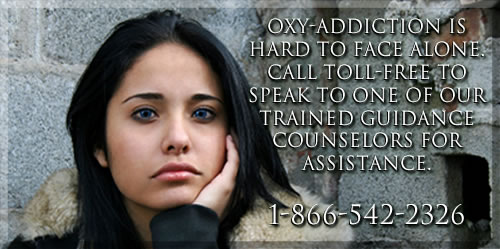OxyContin Addiction
- Signs of OxyContin Use
- OxyContin Addiction Behavior
- OxyContin Withdrawal
- OxyContin Overdose
- OxyContin Detox
- OxyContin Addiction Treatment
OxyContin Facts and Statistics
OxyContin Information

Oxycodone
What is oxycodone? Oxycodone is in a group of drugs classified as narcotic pain relievers. Its effects are similar to morphine. This drug is used to treat moderate to severe pain. The extended-release form of this medication is prescribed for around-the-clock treatment of pain. It is generally not intended for post surgery pain unless you were already taking oxycodone before the surgery.
.jpg)
What type of pain is Oxycodone prescribed for? Oxycodone is given to patients who have received chronic or long term painful side effects from extensive trauma or disease. It is categorized as a Schedule II legal narcotic, meaning it requires a prescription from a doctor. The medication is normally prescribed to older patients with moderate to severe pain. Because of its high rate of addiction, oxycodone is not normally prescribed to younger people. Oxycodone addiction is commonly attributed to chronic pain patients who need daily relief and have no other options available.
What do I need to know about this prescription pain medication? Oxycodone may be habit-forming and should be used only by the person it was prescribed for. Oxycodone should never be shared with another person, especially someone who has a history of drug abuse or addiction. Keep the medication in a secure place where others cannot get to it. Do not drink alcohol while you are taking oxycodone. Dangerous side effects or death can occur when alcohol is combined with a narcotic pain medicine. Check your food and medicine labels to be sure these products do not contain alcohol. Never take more than your prescribed dose of oxycodone. Oxycodone can cause side effects that may impair your thinking or reactions. Be careful if you drive or do anything that requires you to be awake and alert. Do not stop using oxycodone suddenly, or you may experience unpleasant withdrawal symptoms. Talk to your doctor about how to avoid withdrawal symptoms when stopping the medication.
What are common Oxycodone side effects?
Get emergency medical help if you have any of these signs of an allergic reaction: hives; difficulty breathing; swelling of your face, lips, tongue, or throat.
Call your doctor at once if you have any of these serious side effects:
- cold, clammy skin
- confusion
- feeling light-headed, fainting
- seizure (convulsions)
- severe weakness or dizziness
- shallow breathing, slow heartbeat
Less serious side effects are more likely to occur, such as:
- dizziness, headache, tired feeling
- dry mouth
- itching
- nausea, vomiting, constipation, loss of appetite
- sweating
What are the signs of Oxycodone addiction? Even if taken as prescribed, oxycodone addiction creeps up on many patients. Some signs of addiction are insomnia, muscle and bone pain, sweats, chronic vomiting and nausea, stomach cramping, and muscle twitching. The Drug Enforcement Administration (DEA) reports that some 1.9 million Americans have taken oxycodone for illicit use. "Right now it's one of the most abused prescription drugs, and is certainly the most dangerous," one DEA official reported to Newsweek Magazine.
If you feel your loved one is trapped by oxycodone addiction, it is imperative that he or she seek treatment. Oxycodone addicts go through several withdrawal symptoms, so medical care and observation are usually needed to ensure safe cessation from the drug.
